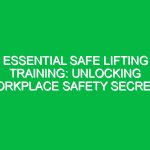Welcome team,
Today, we are going to discuss a crucial topic that directly impacts our safety on the road: Driving Safely Where Deer Are Present. As we navigate through wildlife areas, it’s essential to be proactive and prepared to prevent accidents and ensure a secure working environment. Let’s delve into the best practices and guidelines for deer-proofing your drive.
The Importance of Driving Safely Where Deer Are Present
Driving in areas where deer are present poses unique challenges and risks that require our attention. Collisions with deer can result in severe injuries, damage to vehicles, and even fatalities. By understanding how to navigate these environments safely, we can minimize the likelihood of such incidents and prioritize the well-being of ourselves and others.
Key Aspects of Driving Safely Where Deer Are Present
When driving in wildlife areas, it’s crucial to remain alert and vigilant at all times. Deer are unpredictable animals that can suddenly appear on the road, especially during dawn and dusk. By practicing defensive driving techniques, such as reducing speed, scanning the surroundings, and being prepared to brake quickly, we can mitigate the risks associated with deer encounters.
Potential Hazards and Safety Considerations
Collisions with deer can result in significant damage to vehicles and pose a threat to our safety. It’s essential to be aware of the potential hazards, such as deer crossing signs, and adjust our driving behavior accordingly. By following speed limits, using high beams in low-light conditions, and avoiding distractions, we can enhance our ability to react swiftly to deer on the road.
Best Practices for Driving Safely Where Deer Are Present
Here are some practical tips to deer-proof your drive and ensure a safe journey through wildlife areas:
- Stay Alert: Keep your eyes on the road and scan the surroundings for any signs of deer.
- Reduce Speed: Slow down in wildlife areas to increase reaction time in case a deer crosses your path.
- Use High Beams: When driving at night, switch to high beams to improve visibility and spot deer from a distance.
- Avoid Swerving: If a deer suddenly appears in front of your vehicle, brake firmly and avoid swerving to prevent losing control.
Real-Life Examples and Scenarios
Let’s consider a hypothetical scenario: You are driving through a forested area at dusk when a deer emerges from the trees and crosses the road. How would you react in this situation to ensure your safety and the safety of others on the road?
By staying calm, braking promptly, and avoiding sudden maneuvers, you can effectively navigate encounters with wildlife and prevent potential accidents.
Regulations and Compliance
It’s essential to adhere to all relevant regulations and company policies regarding driving safely in wildlife areas. Compliance with these standards not only ensures our safety but also demonstrates our commitment to upholding legal obligations and promoting a secure work environment.
Conclusion
As we conclude this Toolbox Talk on driving safely where deer are present, remember that our actions on the road can significantly impact our safety and the safety of others. By following the best practices outlined today, we can minimize the risks associated with wildlife encounters and prioritize a secure driving environment.
Thank you for your attention and dedication to maintaining a safe working environment. Let’s continue to drive responsibly and protect ourselves and our colleagues on the road.


